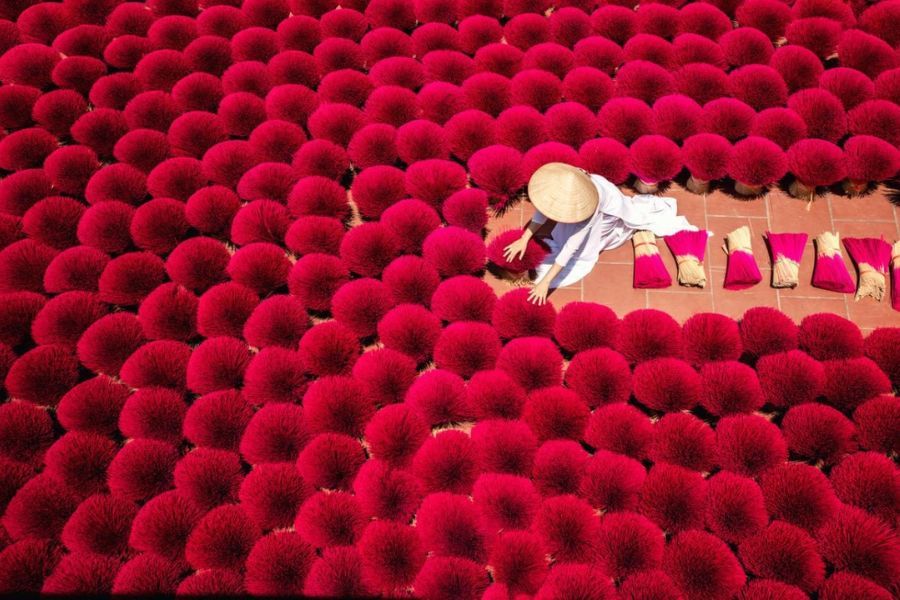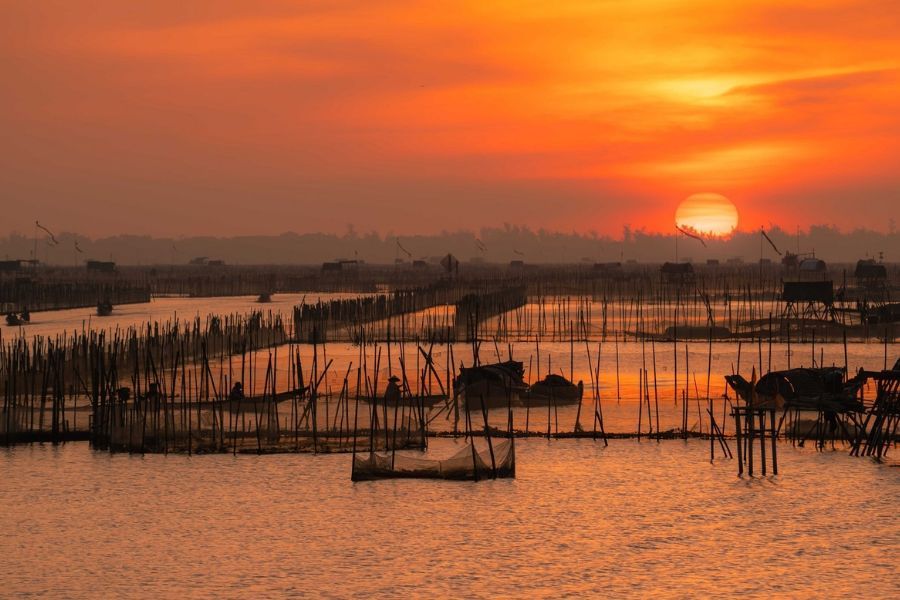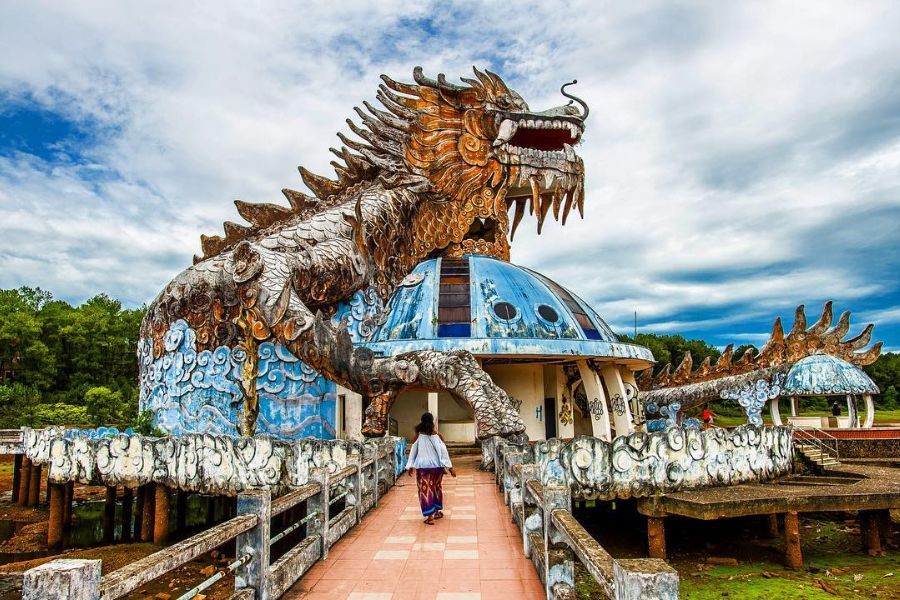Local Guide To Visiting Thien Mu Pagoda Hue With Scenery And Tips
Thien Mu Pagoda stands serenely by the Perfume River, known for its deep spiritual presence, timeless architecture, and layered history. A visit here reveals not just a religious site, but a living symbol of Hue’s cultural identity.
Table of Contents
ToggleIntroduction To Thien Mu Pagoda
Thien Mu Pagoda is one of the most recognizable landmarks in Hue, with a history stretching back to the early 1600s. Situated on a small hill overlooking the Perfume River, this seven-tiered tower and its surrounding temple complex have long been a spiritual and cultural icon of Vietnam. The pagoda is closely tied to Vietnamese Buddhism and remains active today, attracting both worshippers and curious travelers.
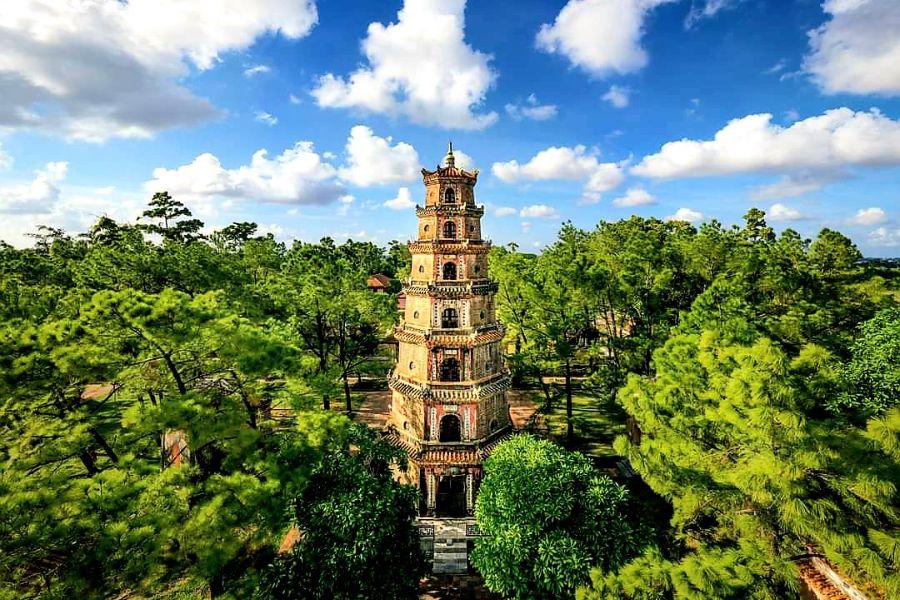
Many visitors include Thien Mu Pagoda in their Hue itinerary not only for its peaceful setting but also for its connection to the city’s deeper heritage. Over the centuries, the site has played an important role in religious life, royal affairs, and moments of political change. It’s also easily accessible from the city center, making it a convenient yet meaningful stop for those exploring the former imperial capital.
History Of Thien Mu Pagoda
The Thien Mu Pagoda’s history began in 1601, when it was first established under the rule of Nguyen Hoang, the founding lord of southern Vietnam. According to legend, a local elderly woman appeared on the hill and foretold that a spiritual leader would build a pagoda to bring peace to the land. Inspired by this prophecy, Nguyen Hoang ordered the construction of the temple on Ha Khe Hill, where it still stands today.
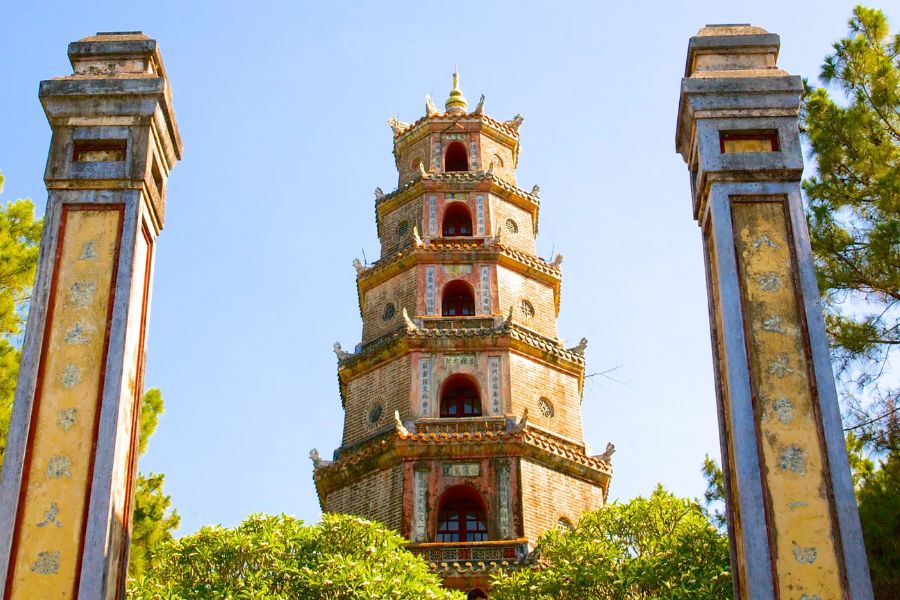
Throughout the Nguyen Dynasty, the pagoda received support from the royal court and became one of the most important Buddhist centers in the region. It has witnessed not only periods of peace and religious growth but also times of political unrest. In the 1960s, Thien Mu gained international attention when a monk associated with the pagoda protested against religious persecution. These layers of history have made the site a powerful symbol of both spirituality and resilience.
Unique Architecture Of Thien Mu Pagoda
The architecture of Thien Mu Pagoda blends traditional Vietnamese design with elements of Chinese and Buddhist influence. While the entire complex is relatively modest in size, it is carefully arranged to reflect harmony, spiritual symbolism, and historical significance.
Phuoc Duyen Tower
This seven-story octagonal tower is the most iconic structure at Thien Mu Pagoda and the one most often seen in photographs of Hue. Built in 1844 during the reign of Emperor Thieu Tri, each level of the tower is dedicated to a different Buddha. The red-brick tower stands 21 meters tall and serves as a symbol of Hue’s religious heritage. Visitors often stop here first to admire its structure and quiet riverside setting.
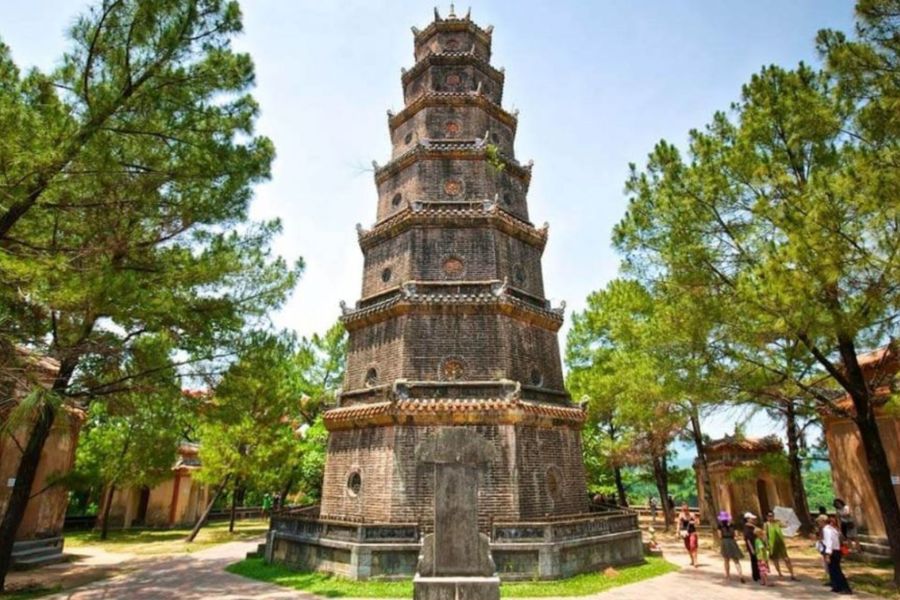
Dai Hung Hall
Behind the tower lies Dai Hung Hall, the main sanctuary of the pagoda. This is where worshippers come to pray and offer incense. The hall is decorated with intricate wooden carvings, lacquered altars, and bronze statues of Buddha, including a large statue of the Maitreya Buddha. Though not grand in size, the hall has a calm and reverent atmosphere that reflects the temple’s spiritual essence.
The Tomb of Monk Thich Don Hau
Further into the complex is the tomb of Venerable Thich Don Hau, a respected abbot who devoted his life to humanitarian work and Buddhist education. His stupa lies in a shaded garden area, often visited by locals who come to pay respects. The presence of his tomb adds a personal, human layer to the site beyond its historic and religious roles.
Bell Tower and Drum Tower
Flanking the courtyard are two smaller towers that house a bronze bell and a wooden drum. The bell, cast in the early 18th century, weighs over two tons and was once used to call monks to prayer and announce important events. These towers help complete the balanced layout of the pagoda and are often appreciated for their craftsmanship.
4 Cultural Experiences You Shouldn’t Miss
While Thien Mu Pagoda is primarily a place of worship, it also offers simple yet memorable experiences that help visitors connect with the local spiritual and cultural atmosphere. Below are some specific activities you can do during your visit.
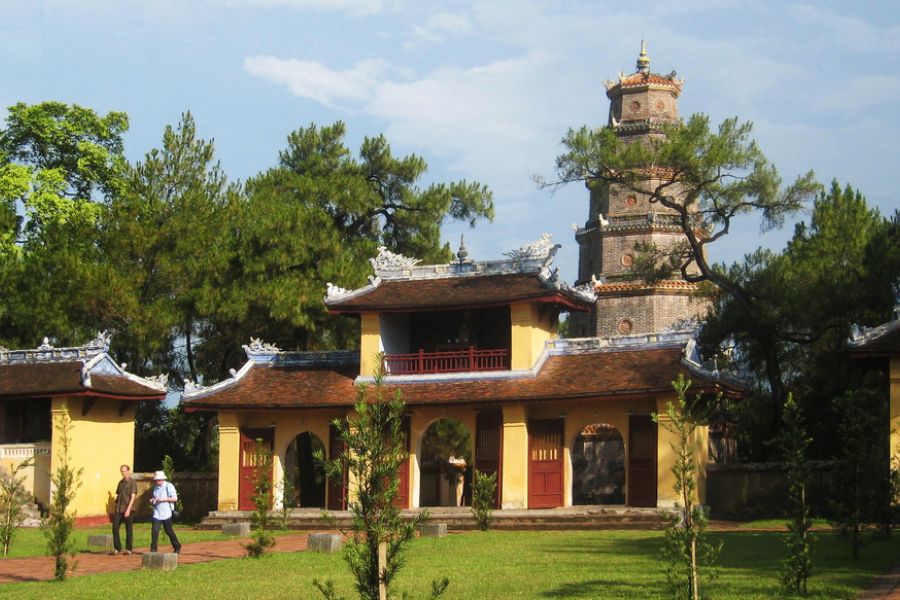
Light Incense In The Main Hall
Upon entering the temple grounds, visitors can approach the main sanctuary and respectfully offer an incense stick. There’s a designated area with incense and a donation box near Dai Hung Hall. Locals often do this while making a quiet wish for health, family, or peace. It’s a peaceful, culturally rooted moment that gives travelers a chance to reflect and take part in a longstanding tradition.
Visit The Monk’s Car (Of Thich Quang Duc)
In a separate building near the back of the complex, you’ll find the preserved Austin car that belonged to Venerable Thich Quang Duc. This vehicle was driven to Saigon (Ho Chi Minh City now) in 1963, where the monk famously self-immolated in protest of religious discrimination. The car is now displayed as a historical artifact, and reading the attached bilingual signage provides powerful insight into Vietnam’s recent past.
Try A Local Vegetarian Meal Outside The Temple
Near the entrance gate, a few small vegetarian food stalls often appear on weekends or during lunar holidays. They serve simple dishes like Com Chay (rice with tofu and vegetables), noodle soups, or sweet soy-based snacks. Prepared according to Buddhist dietary customs, the meals are light and affordable. It’s a casual yet thoughtful way to experience local culture beyond the temple walls.
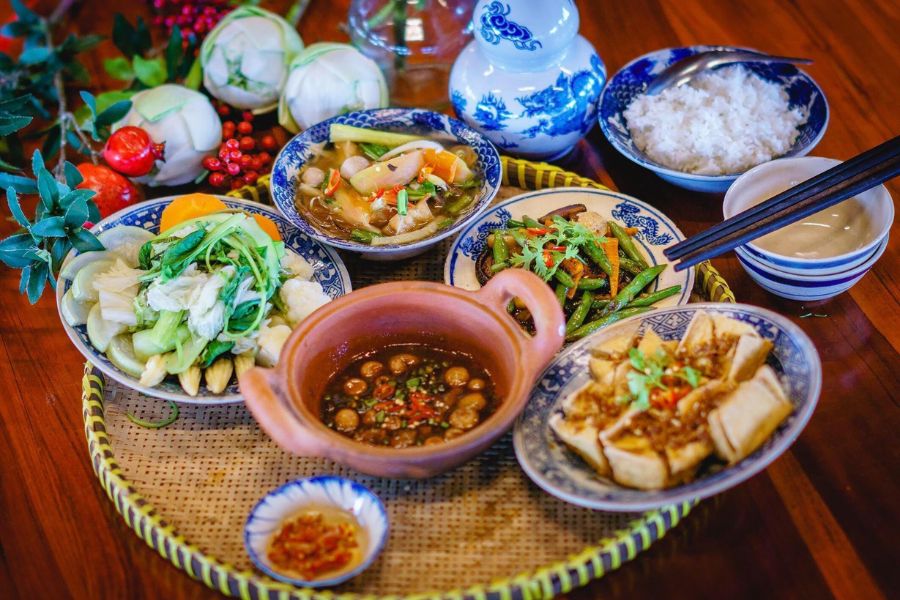
Join A Vesak Celebration If Visiting In May
If your visit falls around late April or May, check the local calendar for the Vesak festival—Buddha’s birthday. Thien Mu Pagoda is one of the most active locations in Hue during this time, with lantern decorations, vegetarian food stalls outside the gates, and large gatherings of monks and followers. Visitors are welcome to watch the ceremonies and take part in the festivities, as long as they dress respectfully and behave quietly.
Entrance Fee
The Thien Mu Pagoda entrance fee is free, and the site is open to all visitors. You can explore the temple grounds, see the main tower, and visit the historical displays without needing to buy a ticket. However, small donations are appreciated and can be placed in collection boxes near the main hall. There are no official tour guides stationed, but some local guides may offer short tours if arranged in advance through travel services in Hue.
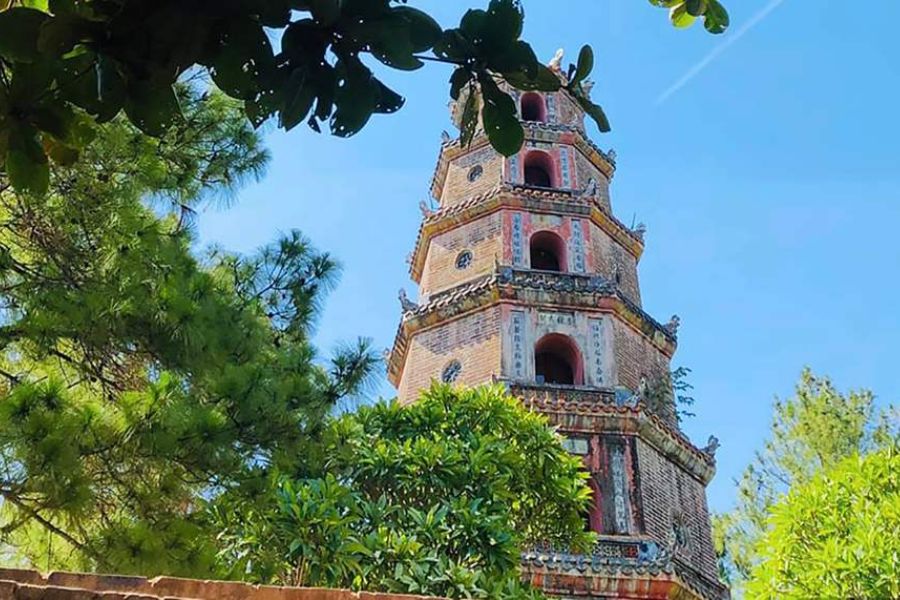
Opening Hours
The Thien Mu Pagoda opening hours are from 7:00 AM to 5:00 PM daily. Visitors can come at any time during these hours without prior booking. For a quieter experience, try arriving early in the morning or closer to closing time when the crowds thin out.
| Detail | Note |
| Opening Hours | 07:00 AM – 05:00 PM (daily) |
| Estimated Visit Time | 30 – 45 minutes |
| Best Season | March to August (dry season) |
| Less Crowded Hours | Early morning or after 04:00 PM |
Hue’s dry season, from March to August, is considered the best time to visit Hue and Thien Mu Pagoda. Skies are usually clear, and the Perfume River below the pagoda reflects the sunlight beautifully. The rainy season, from September to January, sees frequent showers, though the site remains open. If you don’t mind a bit of rain, visiting during off-peak months can offer a more intimate experience.
How To Get To Thien Mu Pagoda
Thien Mu Pagoda is located on Ha Khe Hill, about 5 kilometers west of Hue’s city center, overlooking the Perfume River. Most visitors stay near Le Loi Street or around the Imperial City, where hotels, cafes, and tour services are concentrated. From these areas, it’s easy to reach the pagoda by motorbike, taxi, or by taking a boat along the river.
For those using motorbikes, a Vietnamese or international driver’s license is required. Taxis and Grab drivers are generally familiar with Chua Thien Mu (or Thien Mu Pagoda) as destination names. If you choose the boat route, most dragon boat tours depart from Toa Kham Wharf and follow a direct route upstream along the Perfume River.
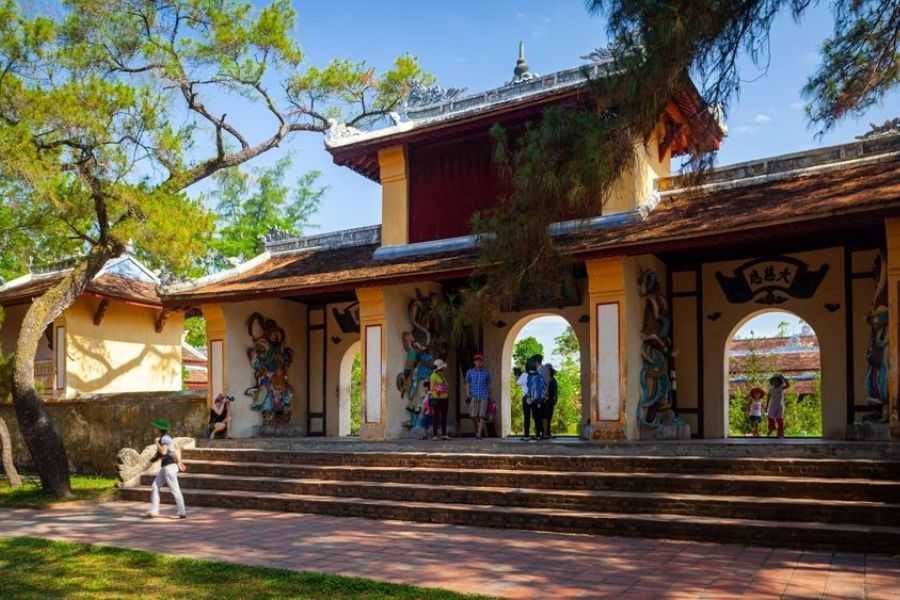
Popular Transport Options:
| Transport Method | Travel Time | Estimated Cost (VND) | Notes |
| Taxi / Grab | 10 – 15 mins | 70,000 – 100,000 | Drivers are familiar with the destination, and the ride is comfortable and quick. |
| Motorbike Rental | 15 – 20 mins | 120,000 – 180,000/day | Foreign travelers must have a valid license; helmets are required by law. |
| Bicycle Rental | 20 – 25 mins | 30,000 – 50,000/day | A scenic and quiet route, best enjoyed in dry weather. |
| Dragon Boat | 30 – 40 mins | 100,000 – 150,000 | Boats depart from Toa Kham Wharf and offer a slower, more relaxing ride along the river. |
Things To Know Before Traveling To Thien Mu Pagoda
Thien Mu Pagoda is a peaceful religious site, and a few simple preparations can help make your visit more comfortable and respectful. The site is open to everyone, but it’s still a functioning temple with its own customs and quiet rhythms.
- Visitors should wear modest clothing that covers the shoulders and knees, especially when entering shrine areas.
- The early morning and late afternoon are the most pleasant times to visit, with cooler temperatures and fewer crowds.
- Shoes must be removed before stepping into indoor halls or worship spaces, as this is customary in Buddhist temples.
- Taking photos is generally allowed outside, but it’s best to avoid using cameras or phones during prayers or ceremonies.
- The temple grounds are quiet and reflective, so speaking softly and silencing phones is considered respectful.
- The walking paths around the pagoda are paved but may become slippery after rain, so comfortable footwear is recommended.
- English signage is limited, so reading a short guide beforehand or visiting with a local guide can help add context to what you see.
- Restrooms are located near the parking area, not inside the main temple complex, so plan accordingly if traveling with children or elderly guests.
FAQs About Thien Mu Pagoda
If you’re planning your first visit to Thien Mu Pagoda, these are the kind of details that can help you avoid small surprises and enjoy the trip more fully.
Is the area around the pagoda walkable, or do I need a vehicle?
You can easily walk around the temple grounds once you arrive, as the site is compact and flat. But to get there from the city center, about 5 kilometers away, you’ll need a motorbike, taxi, bicycle, or boat.
Are boat rides to the pagoda worth trying, or just for the view?
Boat rides are less about convenience and more about the experience. They’re slower than going by road, but they offer peaceful views along the Perfume River. If you have time, it’s a pleasant and scenic way to reach the pagoda.
Is there anything I should bring with me when visiting?
You don’t need much, but a water bottle, sun protection, and small cash for donations will come in handy. If you’re going by motorbike or boat, having a map or navigation app is helpful too.
Final Thoughts: Is Thien Mu Pagoda Worth Visiting?
While there are many things to do in Hue, from grand palaces to historic ruins, Thien Mu Pagoda offers something quieter. For many, this is the spot where Hue finally slows down and starts to feel real. The site may be small, but it connects local history, Buddhist tradition, and the city’s relationship with the Perfume River in one stop. Seni World can help you fit it smoothly into your day, especially if you’re combining it with other cultural landmarks nearby.









